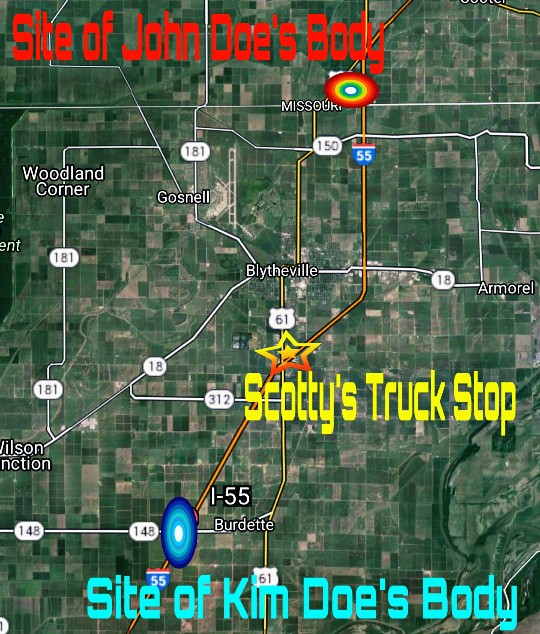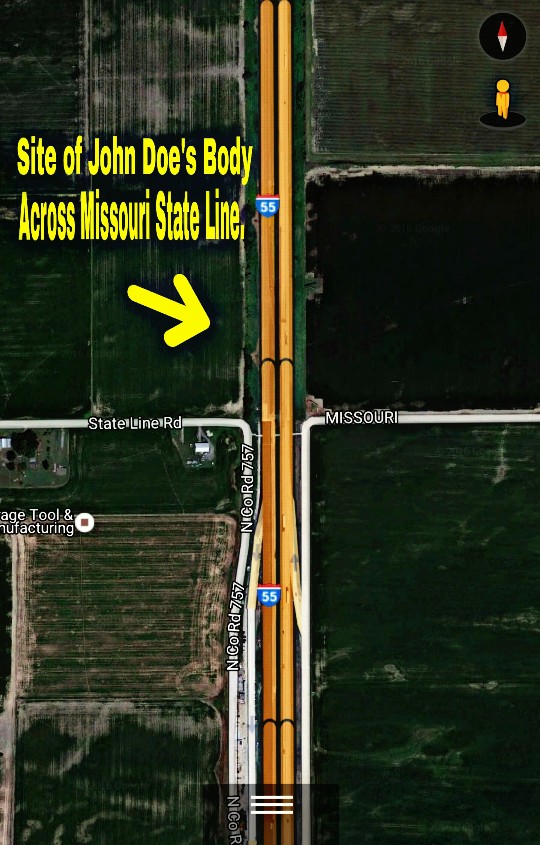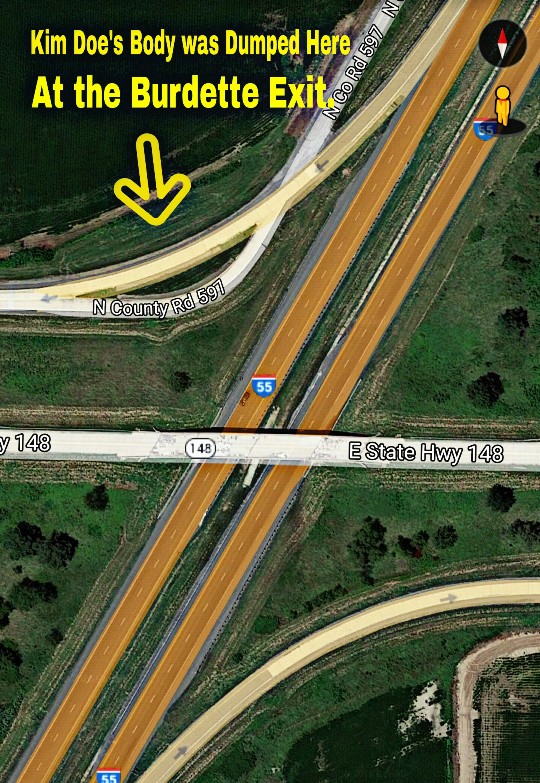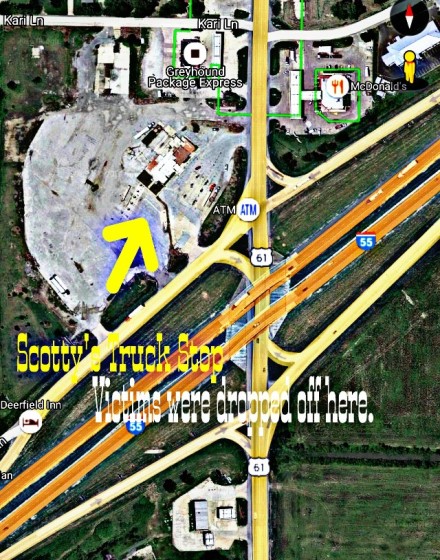
The male’s body was discovered in a field off the South directional side of I-55 and just north of the Missouri State Line in Pemiscot County, Missouri.
The female’s body was discovered just off the Burdette, Arkansas exit, also on the south directional side of I-55 in Mississippi County, Arkansas.
Both victims were murdered by a shotgun, and their deaths have been ruled a homicide and both are still active investigations.
The victims were apparently hitchhikers according to witnesses who had encountered the male and female earlier on June 16, 1978 when the victims were dropped off at Scotty’s Truck Stop (Now Closed) by a local truck driver who worked delivering cars to a local Blytheville car dealership.
The truck stop, now a vacant lot is positioned on the South directional side of I-55 and Highway 61 in Blytheville, Arkansas.
The two victims, according to witnesses inside of Scotty’s Truck Stop (STS) restaurant “were neatly dressed for hitchhikers.” One witness, a waitress, actually approached the female victim and informed her that she could not bring her backpack and bedroll inside and asked her to take the items outside.
What is known about the victim’s movements after leaving Scotty’s is miniscule at best and a matter of debate, because witnesses have come forward and stated that they spotted both the male and female hanging out near a guard rail, and possibly heading southbound on I-55. However, the best known confirmed last sighting would be at Scotty’s Truck Stop.
Presently, both victims have not been identified, however the coroner’s office does have DNA samples to compare with the female victim and at this time, and making the case more difficult to solve is that there is no DNA or other biological samples from the male victim and means he will most likely have to be exhumed from his place of burial and even more disconcerting is most of the evidence in both cases has been destroyed or damaged due to flooding in the Mississippi County Sheriff’s Department and a tornado that hit the Pemiscot County Sheriff’s Department.
To this date, there have been a few attempts to identify the female victim using DNA with female’s who had been reported missing and fit her description but they have been ruled out. There have also been no solid leads as to who committed these two homicides.
JOHN DOE: NAMUS Male Victim, John Doe (JD) In the early morning hours of June 17, 1978 a white male’s body was discovered in a field just over the Missouri state line in Pemiscot County, Missouri on I-55. He was shot three times, once in the back of the head and twice in the neck (the two shots to the neck nearly decapitating him).
The weapon used was a shotgun.
Near the crime scene on the shoulder of the road was what appeared to be a deposit of diesel fuel.
Other miscellaneous items such as a bag of chips, and several empty cans (most of the items may not be linked to the crime and could be considered litter) were found near the victim’s body.
The male victim was wearing a red t-shirt with a logo over the left breast of the image of a brown-haired woman inside of a circle and directly beneath the circle was the words “Hot Sauce”.
The victim is believed to be between the ages of 18-25 (pre-30s), estimated weight was 140 lbs, and his height was estimated to be 68” or 5’8”.
He had medium length, wavy brown hair, small mustache and small beard.
He had blue eyes, a light skin complexion and had freckles.
The victim had several teeth missing.
The victim had a prominent scar in the center of his forehead that extended from his hairline to his eyebrows. He also had a small scar on his left hand on the second joint of his index finger and another scar 2” long on the back of his hand running vertically with his arm.
The male victim also had a tattoo of the letters “J H” on his outer right forearm/elbow.
He was wearing Pentimento brand blue jeans with no belt or front pockets, white shorts and socks. He also had brown or tan size 9 or 10 lace up work boots, and in the heel of the boots contained a Phillips head screw and it is thought they were being used to help hold the heel on.

There were semen samples taken post-mortem by the coroner as evidence.
Her estimated weight was 125 lbs, and her estimated height was 62” or 5’2”.
She had brown hair 4 to 6 inches in length, light brown to blonde in color, being more blonde along the ends away from the scalp, most likely as a result from dying or bleaching her hair.
She had Hazel colored eyes.
Her age is estimated to be between 18-35 years.
On her right arm was a non-professional tattoo of the word “Kim”.
According to autopsy reports, the female had in the past been pregnant at least once and had delivered a baby.
She had a few teeth that had not erupted.
Also on both feet, the female had small “second” or “pointer” toes, as small as her pinky toe.
At the time of her death the female victim was wearing a multi-colored circular striped blouse, consisting of orange, green, dark and light blue colors and blue jeans.
She was also wearing a 24” chain with a mercury dime as a necklace.
At the time of her autopsy her face is severely swollen on the right side because of the shotgun wound to the back of her head, but she is recognizable.

Because both victims have not been identified and very little information is known about them, and because much of the evidence has been destroyed or damaged, there is very little to go on.
If both victims were hitchhiking and transient in nature, it makes it difficult to map out their point of origin.
This report is being conducted in order to determine a narrow search grid as to the origins of the two victims. That’s why each detail, from each scar, tattoo, to the items of clothing become significant and might provide vital clues to help identify the two victims.
Many missing, unclaimed, and unidentified people, such as the two victims have been placed on the NAMUS Data Base . Although this is a very good and detailed database it is possible that many missing people have never been placed on NAMUS, or for that matter ever been reported as being missing or if they had been reported missing it never gained much attention nationally.
It seems unfathomable that anyone could go missing and not be reported, and even more so when you have two victims go unidentified and unclaimed for nearly 40 years. But unfortunately it has happened with these two victims and even worse, this is not an exception to the rule, but there are hundreds of these types of cases all across the country.
Making matters worse is the fact that in the 1970s there was no internet, no cable news networks, and many of these cases go unnoticed nationally, and are typically handled in smaller jurisdictions and in most cases they have few resources available to focus attention on identifying someone who has been murdered or has died in their jurisdiction. In this particular case, the two victims were not only discovered in two separate counties, but two different states: Arkansas and Missouri, even though they were discovered 12 miles apart from each other it further complicates the case.
It is also not known if the two victims were with each other for a lengthy period of time, or had only recently met each other, which makes it difficult to identify both because it would seem that if the two had been known to be together for a lengthier period of time, they would have perhaps been reported missing as being together and missing together, making identifying them easier. But because it is plausible that both victims were both transient in nature, and had only recently met, it’s possible that no one reported them missing altogether.
As a result of all these complications it is important to focus on the smallest of details to at least narrow down the results as to where the two victims may have originated from, either as a couple or as individuals and the most accurate way to do this is to work the victim’s movements backwards.
1. The victims were last seen alive at or near Scotty’s Truck Stop in Blytheville, Arkansas on June 16, 1978. Scotty’s Truck Stop is located right off the South Directional side of I-55 and Hwy 61.

In other words, after leaving STS both victims traveled north bound on I-55 towards the Missouri State Line, and at some point along that route encountered the suspect and either both victims were murdered at the site where JD’s body was discovered, and the female was transported 12 miles south and dumped at the Burdette exit, or only JD was shot and killed at that point and the suspect kidnaps KD, drives south to the Burdette exit and then shoots and kills her at that location.
But if this evidence is accurate, it would seem that the victims were traveling northbound on I-55 at the time of their death, and furthermore it could suggest that the victims had been traveling north on I-55 when they were dropped off at STS.
Therefore, working this case backwards, the evidence suggests that the victims had been hitchhiking and had been traveling northbound on I-55 when they were murdered on June 17, 1978, meaning their point of origin was south of Blytheville, Arkansas.
Knowing this does help determine a directional route the victims were taking, but because of the aforementioned interchanges along I-55 south of Blytheville, at any point the victims could have met along that route, and also that they could have been traveling from any direction prior to intersecting with I-55 and then heading northbound.
It is also plausible that the two utilized highways at times, or had even been hitchhiking for a lengthy period of time. It is possible that the two traveled only a short distance and originated from an area only a few miles from where they were murdered.
However, this scenario seems unlikely because if they had originated from a point less than a hundred miles from the Blytheville area, it would seem the two victims murders would have made local news and subsequently they’d be identified. Nevertheless it is plausible.
Because of all the unknowns, and all the variables, and complexities in determining as to the victims origin and how they came to be at STS, the evidence found at the crime scenes, such as the items of clothing the victims were wearing may help determine a regional direction as to where one or both victims originated from.
Since the evidence suggests that both victims were traveling northbound on I-55 when they arrived at STS, it shows that they had set out on their journey from a point south of STS. It is impossible to know if at some point along their journey they had been for example traveling east or west on I-40 and then once in the West Memphis area, south of Blytheville began traveling northbound on I-55, the items of clothing the victims had on their bodies might help establish a narrower point of origin.
1. The male victim at the time of his death was wearing a red t-shirt with a logo on the left breast of a brown-haired woman inside of a circle and directly underneath the words “Hot Sauce” was written.
2. The female victim at the time of her death was wearing a 24” necklace with a mercury dime attached to it.
The T-shirt: there is no information as to the manufacturer of the t-shirt. It is also unknown if the logo on the shirt had been for a specific brand of hot sauce or if it were a novelty type shirt that was not linked to a specific brand.
It is also not known if this was a popular nationally sold t-shirt or a novelty type shirt sold at a specific local retail location as a marketing tool for a type of hot sauce brand. It is possible however that the shirt was damaged as a result of the two shotgun wounds to the neck which could have also damaged the shirt and destroyed any lettering that might have been on the shirt that could have pointed to a specific brand of hot sauce. However, with that said, the t-shirt could provide a vital clue as to the origins of the male victim.
For example, if the victim had been wearing a popular logo sold nationally, the shirt would be an insignificant clue. But because it could be a branded logo from a smaller, local or regional hot sauce brand, it might be possible to determine the origins of the t-shirt, where it was sold, and might could help narrow down the point of purchase and give investigators a narrower search perimeter to see if any missing person’s were reported from that specific area.
The Mercury Dime Necklace: Mercury dimes are still being sold today online. They are also regarded by some as good luck charms. In many of the references concerning the silver mercury dimes it seems to be regarded as a gambler’s type charm in Hoodoo culture.
LUCKYMOJO
1. Although hot sauce is sold worldwide and a popular condiment consumed daily, and in recent years specialty retail stores have popped up that sell only hot sauce items on their shelves, and carry several thousand starter independent brands that can be bought at these types of retail specialty stores and online currently.
However, when one thinks of the origins of hot sauce outside of North America, Louisiana often stands out. In 1978, there weren’t as many independent brands of hot sauce as there are today on the market, but there were a few brands that had been available for sale, and in Louisiana there were several popular wholesale brands, some of which are still around today, and some have been acquired by other businesses.
Hot Sauce is celebrated in Louisiana annually at the Cajun Hot Sauce Festival also.
2. Hoodoo is a traditional African Folk spirituality with several deep rooted spiritual traditions and beliefs. One of the core purposes of Hoodoo is to help access supernatural forces to improve people’s lives and to attain success.
The Mercury dime is seen as a good luck charm in Hoodoo traditions. In southern Louisiana, and places like New Orleans Hoodoo is still practiced to this day and is also a major attraction for tourist who visit shops that sell souvenirs and spiritual items.
Although it is inconclusive, there may be a connection to the t-shirt the male victim was wearing and the Mercury Dime Necklace the female victim was wearing at the time of their deaths to link them to the Southern Louisiana region.
Also, as mentioned before, I-55 originates at the southern end in Louisiana. Even though it is not conclusive evidence that one or both of the victims originated from Louisiana, it can’t be ruled out either.
It is possible that the t-shirt the male victim was wearing was a shirt sold from a retailer made to advertise a brand of hot sauce, or it could have perhaps been a shirt worn by workers who worked in a factory that made or produced hot sauce, or a shirt worn by a person who worked in a retail shop that sold hot sauce.
However, because there is no brand name on the shirt this evidence is inconclusive. Even so, it is possible that the victim’s gunshot wounds may have damaged the upper portion of the t-shirt and because of this destroyed the brand name from being legible by law enforcement.
The Mercury Dime link to Louisiana is also inconclusive, because Mercury dimes are not only sold in that area but nationwide. However, when both pieces are put together it makes a more compelling case that perhaps one or both victims originated from the Louisiana area.
Furthermore, it should be also noted that when both items are put together along with the evidence that the victims were traveling northbound on I-55, it is a plausible theory that one or both victims originated from Louisiana, traveled together from there, or one met the other along the route and made their way up north to Blytheville.
Again, even though these are theories, and inconclusive, they cannot be ruled out altogether and it might help narrow down a possible point of origin as to where the victims came from.
Physical evidence: male victim: scars, missing teeth. Female victim: pregnancy, teeth that had not erupted, small second toes on both feet.
1. The male victim had a significant scar on his forehead running from his hairline to his eyebrow. He also had a significant 2” scar on his right hand. He also had several teeth that were missing. Although it is unknown as to how the victim received these scars, and had lost his teeth it is possible to surmise several theories. However, it should not be an obvious conclusion that the male victim had had these scars for years. He could have sustained injuries after being reported missing if in fact the male victim had been missing for an extended period of time before he was murdered.
So for example if the male victim had been reported missing by loved ones months before, and the male victim had left on his own volition, and was not a victim of foul play, the loved ones and researchers looking for the identity of a male with scarring as described above may over look unidentified males that fit the male victims physical attributes.
The assumption should be that unidentified males reported missing prior to 1978 with or without scarring should not be excluded because he could have received the scars after being reported missing by loved ones.
Although it seems his scarring and tooth loss is indicative of an individual who had lived a hard life,it should be taken into account that he might had come from a stable middle class or upper class family and at some point decided on his own to leave on his own volition and the scarring and tooth loss came after leaving. However, none of this conclusive, and it's possible he was never reported missing.
Nevertheless, with all this said, it can't be ruled out that the male victim may have had a neurological Behavioral disorder such as bi-polar or a drug induced Behavioral disorder etc. that may have never been diagnosed.
As a result t’s also possible that he may have spent time institutionalized for mental health issues. As a result it could explain as to why the male victim may not have been reported missing, and or why he went missing to begin with and suggests that he had been a transient or homeless for quite some time before 1978. So, the operating theory is that it's possible the male victim was reported missing years earlier when he had no scarring.
However, this does not suggest that the male victim had been hitchhiking for an extended period of time prior to his death, but that after leaving and being reported missing by loved ones he left on his own volition, moved to another state/city/assumed another identity, and his lifestyle changed. It's plausible that as a result he was not able to gain stable employment became transient and decides to try his luck elsewhere with the unidentified female victim.
2.The female victim’s autopsy determined that at some point, and at least once she had been pregnant and had a baby. It also showed that she had several teeth that had not erupted. And another prominent deformity was that on both feet her second or “pointer” toe was significantly small, like the size of her pinky toe.
(this above information is awaiting confirmation from the Arkansas State Crime Lab)
The evidence of several teeth having not erupted and smaller second metatarsal stands out, because it could be an indicator of a genetic abnormality. It’s possible that she had a form of Brachydactyly or Bracymeatarsia. There may also be a genetic link to Brachydactyly and Brachymetatarsia with an adult whose teeth had not erupted such as Down Syndrome.
Although this is purely speculative it should be considered because it is possible that she had also spent time institutionalized in a hospital.
It should also be considered that if the female victim’s smaller 2nd metatarsals are as a result of genetics and not as a result from trauma, that someone in her family also has this and it might help in identifying the victim.
It’s completely plausible to infer that the female victim may have also had a Behavioral disorder like and as a result it’s plausible that her baby was removed from her care because she was not capable of taking care of the baby.
However, the information concerning the metatarsals could also be a result of trauma and also might be vital information in helping to identify her.
However, all these things should be taken into consideration. This may be a factor in determining her origins, and also why she may not have been reported missing, because she may have at some point been a ward of the state, with no family, or perhaps even her own family had been unfit to care for her and the female victim were removed from her home But like the male victim, it's plausible that the female victim had also been reported missing by a loved one and had runaway or left home on her own volition months or years prior to 1978. Although many missing persons cases when a juvenile runs away or are reported missing are a result of abduction or foul play, the operational theory is that the female victim in this case had at some point left on her own volition either as an adult or juvenile and also traveled to another state/city/assumed another identity, attempted to gain employment and was unable to do so and became transient. She meets the male victim and they decide to hitchhike together for unknown reasons.
Even though it is difficult to provide any conclusive evidence to support any of these theories, it may provide enough information to begin searching in a regional area.
It is impossible to determine with the available information as to how long the two had been hitchhiking, and it’s possible they may have come from virtually any place on the map to end up in Blytheville, Arkansas.
It is also possible that both victims may never be identified, but these clues may help determine a point of origin as to where the victims came from and might help aid in narrowing down a specific region in which to focus on research regarding any missing person’s using the aforementioned evidence to help identify the two victims.
Theory of origin and movements that led the victims to the place they were murdered:
The two victims were not strangers, at least not in the sense that they had only met recently when one of the victims decides to hitchhike. However, the two victims may have only known each other for a short period of time, perhaps a few months.
One possible theory is the two victims met each other while hospitalized, or had been incarcerated together, or met in a homeless shelter. It’s also possible that the reason they decided to leave the area was because they had no family, and only each other, and after giving up her baby, the two decided to try their luck elsewhere. It is plausible that both victims were not well educated, came from broken homes and a poor socioeconomic background and may have had some disability and had this in common and the male victim felt as if he were her protector. But it would seem that had they been a couple and reported missing as being together, identifying them would be an easier task.
Using the aforementioned evidence it is possible that both victims had at some point before 1978 left home or their families on their own volition and had not known each other at that point but met later on by chance, but the operating theory is that before being murdered in Blytheville, Arkansas and based on the clues mentioned above, at some point before June 16, 1978 the two victims had been in southern Louisiana and both victims began their journey up I-55 and may have only been on their journey for one or two days, depending on if they were able to get rides as a result of hitchhiking before arriving in Blytheville, Arkansas on the morning of June 16, 1978 at Scotty’s Truck Stop.
After leaving Scotty’s Truck Stop their movements are unknown, but the most likely scenario is that the two victims may have started traveling northbound on I-55. However, they may have stayed nearby Scotty’s in an attempt to hitch a ride with a trucker who was heading northbound and when their attempts failed they set out on foot.
According to weather reports on June 16, 1978, the temperature reached 93 degrees, and it’s possible the victims found a shady place to rest and wait for temperatures to drop before continuing their journey. Although the distance between Scotty’s Truck Stop and the Missouri State Line is approximately 9 miles, to walk that distance would take about three hours depending on how fast the two victims travelled.
So it’s possible that the victims did not depart the Blytheville area until sundown and wouldn’t have reached the Missouri State Line until 10 or 11Pm.
At some point while walking down the North Directional side of I-55 the suspect, most likely a truck driver noticed the two hitchhikers, but did not stop immediately, but slowed down, and perhaps considered driving on, but as he approached Exit #1 in Missouri, he changed his mind and took the ramp and turned his rig around and proceeded back onto I-55 going south.
As the driver approached the victims, he slows down his rig and parks on the shoulder of the road. The driver engages the two victims, who most likely by this time were tired of walking, and they cross over the median and meet the driver. The driver is inviting and courteous and offers them a lift and the two victims accept.
The female victim enters into the truck carrying her pack and bedroll and places them into the truck followed by the male victim, and they are quickly ambushed by the driver.
The driver subdues the woman, perhaps hitting her and incapacitating her, and the male victim flees in a panic. The driver grabs his shotgun leaves the cab of the rig with the female victim inside and gives chase.
He fires his first shot hitting the male victim in the back of the head, dropping him to the ground. The driver then walks up closer to the victim and fires two more shots into the victim’s back killing him.
The driver then returns to the rig and leaves the crime scene and the male victim on the side of the road. The driver continues southbound and looks for a place to pull over to possibly sexually assault the woman and the next few exits are through Blytheville, and offer him little privacy, so he proceeds forward until he finds the more secluded Burdette exit and pulls onto the exit ramp and parked his rig.
After the driver has sexually assaulted the female victim, he forcefully removes her from the cab of the vehicle, walks her into the ditch, and then executes her by shooting her in the back of the head killing her.
The driver then returns to his rig, gets back onto the road, turns around and enters back onto I-55 heading northbound leaving the crime scene.
Conclusion: From the available evidence known about the crimes and the victims, it’s possible to deduce that the victims may have been from or at some point before June 1978 in the southern Louisiana region.
Although, inconclusive, it might help to research area hospitals that specialized in mental health in the southern Louisiana area. It is possible that the victims met while hospitalized or institutionalized at some place together. One may have been released sooner and waited and found work in the area for the other to be released, or they may have both been released together and attempted to find work and were unsuccessful and as a result decided to try their luck elsewhere.
It’s possible they had been wards of the state and had no family to go to or no one to report them as being missing. It’s possible that both victims had been abused, while in the care of others, and this may have furthered their desire to move away from that area and hitchhike.
Again, this is only a theory based on evidence taken from the crime scene, and autopsy reports in the hope to help narrow down a specific region in order to identify the two victims.
However, it should be noted and not ruled out that prior to June 1978, the two victims may have not known each other and had met by chance and both victims had gone missing sometime prior to 1978, by months/years, and had been reported missing in two different states by two different families.
Anyone having any information please contact the Mississippi County, Arkansas Sheriff's Department at 1-870-762-2243 or the Pemiscot County, Missouri Sheriff's Department at 1-573-333-4101

WWW.MISSINGKIDS.ORG